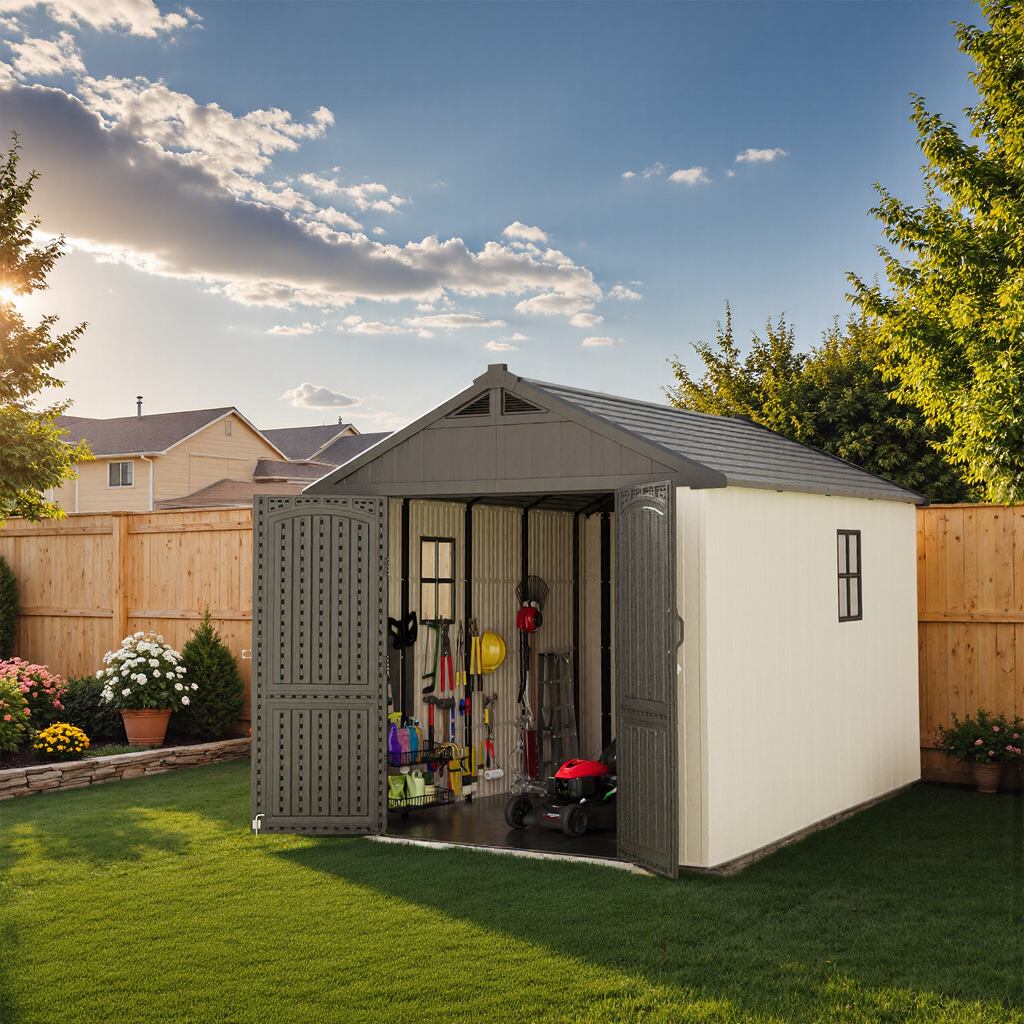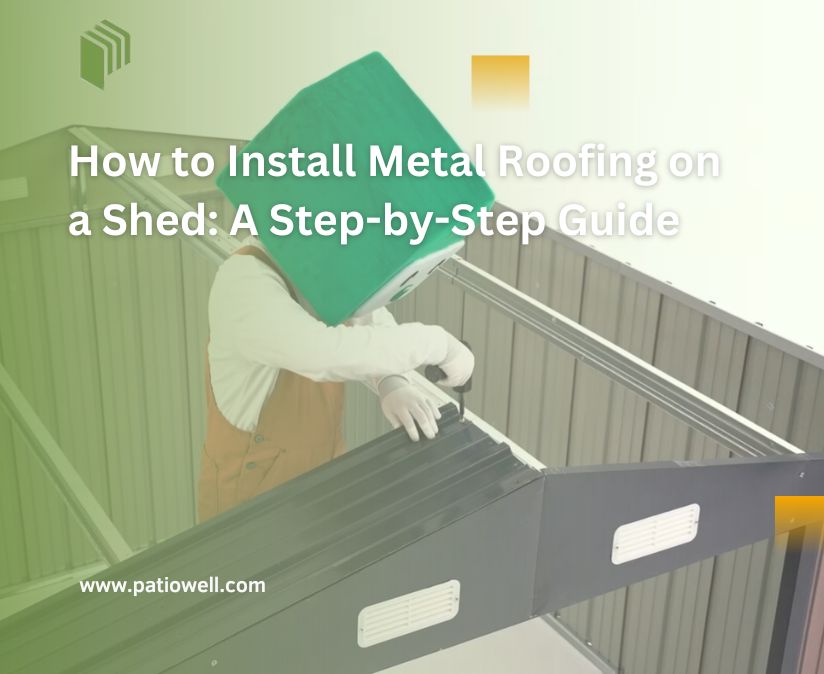Plastic sheds—sometimes called resin sheds—are popular modern alternatives to traditional wood and metal storage options. Lightweight yet functional, they offer unique advantages and a few trade-offs. Read on to explore whether a plastic shed fits your backyard needs.
Table of Contents:[hide]
What Is a Plastic Shed?

A plastic shed is an outdoor storage structure made from molded plastic—typically high-density polyethylene (HDPE) or PVC resin. Unlike wood or metal, these sheds feature lightweight panels that snap or screw together, often with minimal tools needed. Despite their lightweight nature, quality models include UV-resistant, double-walled panels and reinforced flooring options to protect tools, bikes, cushions, and seasonal décor. They’re maintenance-free, rot-proof, and rust-resistant.
Pros of Plastic Sheds
1. Low Maintenance & Weather Resistance
Plastic won’t rot, rust, or succumb to insect damage—unlike wood or metal. UV-treated plastic resists fading and warping over time.
2. Quick & Easy Assembly
These sheds often feature interlocking panels or snap-together designs. Many models don’t require tools, making them friendly for DIYers and beginners.
3. Lightweight & Portable
Weighing significantly less than wood or metal, plastic sheds can be relocated or disassembled easily—ideal for renters or those who may move homes.
4. Cost-Effective
On average, plastic sheds cost less upfront than comparable wooden or metal models. Many retail between $300–$800, offering excellent value.
5. Resistant to Mold & Pests
Since they don’t absorb moisture, plastic sheds prevent mold, mildew, and pest infestation more effectively than wood.
6. Aesthetic Versatility
Modern designs replicate wood grain or sleek styles and come in neutral colors—offering durability without looking industrial.
Cons of Plastic Sheds
1. Less Structural Strength
Plastic sheds are generally lighter-duty than wood or heavy-gauge metal, which may limit load-bearing or long-term wear.
2. Expand & Contract in Extreme Temperatures
In extreme heat or cold, plastic can warp, crack, or bow. This may affect seal tightness and weatherproofing.
3. Lower Security
Plastic doors and latches are easier for intruders to breach compared to reinforced wood or metal locks.
4. Wind Vulnerability
Lighter panels may lift or shift in high winds unless properly anchored.
5. Limited Customization
Unlike wood sheds, plastic models can’t be cut or modified easily, limiting personalization for shelving or windows.
6. Shorter Lifespan
Typical life expectancy ranges from 10–20 years—less than wood (15–30 years) and metal (20+ years).
How Do Plastic Sheds Compare to Wood and Metal?
A side-by-side comparison highlights where each material excels:
|
Feature |
Plastic |
Wood |
Metal |
|
Maintenance |
Very low |
High (painting, rot prep) |
Low to medium (rust care) |
|
Durability |
Medium (10–20 yrs) |
High (15–30 yrs) |
High (>20 yrs) |
|
Easy to Assemble |
Very easy |
Moderate (cutting, screws) |
Harder (heavy parts) |
|
Theft Resistance |
Low |
Medium |
High |
|
Weather Resistance |
Good |
Good with care |
Susceptible to heat, rust |
|
Customizable |
Low |
High |
Medium |
|
Cost |
Low–medium |
Medium–high |
Medium |
Plastic sheds strike a balance: maintenance-free and easy to assemble, though less robust under heavy conditions. Wood is more customizable and sturdy, while metal is toughest but more prone to rust and cold-related issues.
Best Use Cases for Plastic Sheds
These scenarios play to the strengths of plastic designs:
1. Urban or Small Backyards
Compact storage units (4x4 to 6x4) fit small spaces without sacrificing weather protection.
2. Tool & Garden Storage
Great for lawnmowers, shovels, pots, and garden tools—no risk of rust or rot.
3. Seasonal Item Storage
Perfect for holiday décor, patio cushions, and light gear that require dry conditions.
4. Temporary Storage Needs
Easy to rent or relocate when moving or remodeling.
5. Rental Properties
Non-permanent, legal compliant in most areas, and tenant-friendly due to ease of removal.
These use cases are echoed by plastic-shed adopters on platforms like Amazon, Home Depot, and Walmart.
What Real Users Say About Plastic Sheds
Here’s feedback from actual owners:
- One Rubbermaid resin shed user reported over 15 years of outdoor use, surviving storms and remaining functional.
- Keter Manor resin sheds earn praise for withstanding 70 mph winds, heavy rain, and storms with no leaks.
- An Asofer 6x4 ft shed review mentions “weather-tight, waterproof, UV-resistant flooring,” and easy assembly with just a drill.
- Expert comparisons highlight lack of rust, rot, and low upkeep as major selling points.
Recommended Plastic Sheds from Patiowell
Patiowell offers top-quality resin sheds that combine these benefits:
- Patiowell 4x8 Plastic Shed – Compact, weatherproof, ideal for tools and small equipment.
- Patiowell 8×10 Plastic Shed – Spacious, double doors, reinforced floor—great for bikes or lawnmowers.
- Patiowell Kick‑it Series – Made with heavy-duty HDPE and optional shelving for an organized setup.
All Patiowell models feature UV resistance, lockable doors, and easy DIY assembly—supporting reshuffling, relocation, and long-term use.
FAQs
Do plastic sheds need a foundation?
Yes—a level platform (pavers, gravel, wood) prevents moisture buildup and ground shifting. Without it, your shed may warp or shift.
How long do plastic sheds last?
Expect 10–20 years of use. Top-tier resin sheds with UV and structural integrity last longer. Outdoor placement and climate conditions apply.
Can you secure a plastic shed against theft?
Yes—use reinforced padlocks, anchor to concrete, add internal locking latches, or install ground anchors. Metal locks significantly boost security.
Are they safe in snowy or windy areas?
In moderate conditions, properly anchored plastic sheds hold up well. For heavy snow or strong winds, choose resin models with reinforced roofs or consider anchoring strategies.
Conclusion
Yes—plastic sheds are a great choice for many homeowners and renters. They deliver hassle-free installation, reliable weather protection, and outstanding value. Though they won’t match wood’s customization or metal’s toughness, for tool storage, seasonal gear, and compact space solutions, Patiowell plastic sheds offer exceptional performance and longevity.
If you're ready to clear clutter without compromise, explore Patiowell’s plastic shed lineup today. Let me help you pick the perfect size and setup for your backyard!
Diana Mason
Hi there! I’m Diana Mason, the chief editor of Patiowell brand. With over 15 years of diving deep into the world of outdoor furniture, I’ve developed a keen eye for what makes outdoor spaces truly special. I love sharing tips and inspiration to help you create your perfect backyard retreat. Our blog is a reflection of my passion and expertise, featuring only the best pieces that I personally vouch for. Thanks for stopping by—I can't wait to help you transform your outdoor living space!









Leave a comment
All comments are moderated before being published.
This site is protected by hCaptcha and the hCaptcha Privacy Policy and Terms of Service apply.